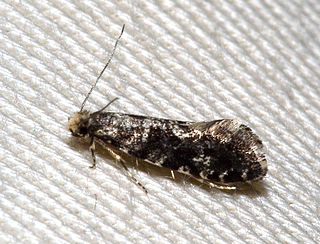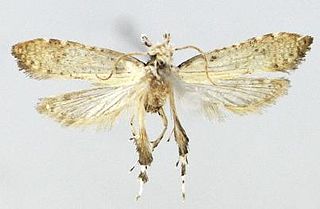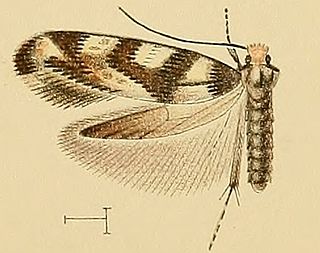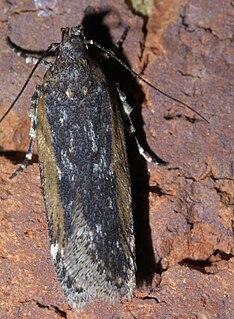| Tinissa leguminella | |
|---|---|
 | |
| Scientific classification | |
| Kingdom: | Animalia |
| Phylum: | Arthropoda |
| Class: | Insecta |
| Order: | Lepidoptera |
| Family: | Tineidae |
| Genus: | Tinissa |
| Species: | T. leguminella |
| Binomial name | |
| Tinissa leguminella Yang & Li, 2012 | |
Tinissa leguminella is a moth of the Tineidae family. It is found in Yunnan, China. [1]

Moths comprise a group of insects related to butterflies, belonging to the order Lepidoptera. Most lepidopterans are moths, and there are thought to be approximately 160,000 species of moth, many of which have yet to be described. Most species of moth are nocturnal, but there are also crepuscular and diurnal species.

Tineidae is a family of moths in the order Lepidoptera described by Pierre André Latreille in 1810. Collectively, they are known as fungus moths or tineid moths. The family contains considerably more than 3,000 species in more than 300 genera. Most of the tineid moths are small or medium-sized, with wings held roofwise over the body when at rest. They are particularly common in the Palaearctic, but many occur elsewhere, and some are found very widely as introduced species.

Yunnan is a province of the People's Republic of China. Located in Southwest China, the province spans approximately 394,000 square kilometres (152,000 sq mi) and has a population of 45.7 million. The capital of the province is Kunming, formerly also known as Yunnan. The province borders the Chinese provinces Guangxi, Guizhou, Sichuan, and the Tibet Autonomous Region, as well as the countries Vietnam, Laos, and Myanmar.
The wingspan is 16.5–19 mm for males. The forewings have a brown ground color, shining dark purplish, scattered with conspicuous white spots throughout, regularly arranged along margins as well as between veins. The hindwings are pale grayish brown, shining dark purplish, with small pale dots apically.

The wingspan of a bird or an airplane is the distance from one wingtip to the other wingtip. For example, the Boeing 777-200 has a wingspan of 60.93 metres, and a wandering albatross caught in 1965 had a wingspan of 3.63 metres, the official record for a living bird. The term wingspan, more technically extent, is also used for other winged animals such as pterosaurs, bats, insects, etc., and other fixed-wing aircraft such as ornithopters. In humans, the term wingspan also refers to the arm span, which is distance between the length from one end of an individual's arms to the other when raised parallel to the ground at shoulder height at a 90º angle. Former professional basketball player Manute Bol stands at 7 ft 7 in (2.31 m) and owns one of the largest wingspans at 8 ft 6 in (2.59 m).








